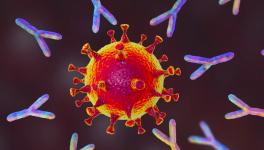What it is Really Like to be a Bat
The ongoing pandemic has shaken the world, and got everybody thinking about therapies and vaccines against COVID-19, the disease caused in humans by the now well-known SARS-COV-2 virus. It is also established by now that bats were the original host of this virus, which has gone on to infect humans. Beside SARS-COV-2, the SARS, MERS, Rabies, Marburg, Nipah and Hendra viruses were also hosted in bats, and from there jumped to infect humans.
However, the biological characteristics of bats that make them a haven for such viruses is yet to be fully uncovered. Scientists are grappling with why bats do not develop severe diseases from these viruses, as happens to humans. Insights into the physiology of bats, which seems capable of training viruses to survive against the defence system of human beings, can help fight this and other future epidemics. Bats and their interaction with viruses can also provide scientists answers on some puzzling questions about zoonotic jumps, so that we can better manage the next viral epidemic.
Bats are a diversified group of mammals with very high species diversity. There are over 1,300 bat species, which make up over 20% of the total recognised species of mammals. They are widely geographically distributed—found everywhere except along the Arctic circle and Antarctica, and they have a relatively long lifespan. These factors, along with the social behaviour and feeding habits of bats, determine the extent and possibility of their exposure to viruses.
The database of bat-associated viruses, DbatVir, presently contains over 11,000 viruses belonging to 28 families, only a fraction of which are currently known to infect humans. Surprisingly, over 80% of the known bat viruses have RNA as their genetic material. However, the ability of bats to harbour such a large number of viruses without any significant pathological consequences suggest that they have made adaptations or developed tolerance to antiviral immune responses.
Mammals use an “innate immune system” such as Pattern Recognition Receptors or PRRs, which are basically proteins with a capability to recognise pathogens. When PRRs detect a pathogen-specific molecular structure or damaged-cell derived molecules, they send signals to body cells to produce anti-microbial and/or inflammatory mediators. In bats, this process is very finely tuned, in that the PRRs create immune responses to the virus which limit the replication of the virus.
At the same time, it has been found that in bats, the inflammatory response is restricted or controlled, so that it does not bring about the destruction of the bat’s own tissues. Such cell destruction can take place in other mammals as a result of the immune system kicking into overdrive.
A dampened inflammatory system in bats is also linked by scientists to their longer life span (keeping in mind their size and metabolic activity) and it is also seen to be connected with the relatively lower incidence of cancer in them.
By contrast, when human beings respond to viruses, there can be an exaggerated inflammatory response. It is this response which is known to contribute to the severity of certain infectious diseases, including COVID-19, in humans. For this reason, scientists consider it important to develop a better understanding of inflammatory responses and viral messaging systems among mammals—including bats—for this can help develop new treatments for viral infections.
Why bats have relatively low levels of activity in the inflammatory arm of their immune system is a question still open to answers. Some believe that the evolution of flight in bats is at the root of this peculiar adaptation. Bats need a high metabolic rate in order to support the increased muscle activity associated with flight. This higher metabolism is accompanied by raised body temperatures (41 degrees centigrade—as compared with 37 degrees in humans). Flight and higher metabolism are also linked to the accumulation of Reactive Oxygen Species or ROS, which are highly reactive oxygen-containing molecules.
Both these factors—higher temperatures and accumulation of ROS—promote excessive DNA damage. Fragments of this damaged DNA are released from their usual location within the nucleus of each cell to the cytosol, where other cellular biomolecules and organelles are suspended in fluid. When a bacteria or virus invades a cell, the PRRs recognise the breach: they detect the different foreign molecules and trigger a defence response against the invader. The same response can, however, be activated by accident when the cell’s own DNA leaks from the nucleus into the cytoplasm.
In bats, along with flight evolution came two adaptations: to minimise the harmful effects of an excessive inflammatory response to released DNA fragments, the genes that repair the DNA have undergone positive selection. That is, the DNA repair-work is more effective, leading to fewer chances of triggering an immune response. Meanwhile, the important cytosolic sensors of DNA are also attenuated in bats—that is, the cells tend not to overreact when they detect DNA floating around outside the nucleus.
Studies have further revealed that bats have relatively fewer immune-related genes compared to humans. For instance, an entire gene family (the PYHIN), which plays a key role in antiviral responses and inflammation, is absent in many bat species. Other important mediators of the immune response in mammals including NLRP3 inflammasome, cGAS-STING and NFkB pathways are also dampened in bats.
There is another layer to understanding bat tolerance to viruses and the immune system. As discussed above, they have frequent exposure to higher body temperatures than most other mammals. In other words, they are in a “fever”-like state during flight, a state which is observed in other mammals when they are infected.
Fever is a protective response against pathogens. It has a beneficial effect in that it boosts the activity of immune cells. Second, higher temperatures are directly detrimental to the infection-causing agent. What happens in bats is that due to frequent exposure to high temperatures, their immune cells probably do not get activated to the same extent during infections as in humans.
It is also possible that the viruses that invade bats have grown accustomed to their relatively high body temperature. Fever, in humans, has virus-fighting properties, but when a virus jumps from a bat to a human, it is quite possible that the virus is already trained to deal with higher temperature.This may well be a reason why when bat-borne viruses infect other mammals, they tend to cause a higher incidence of illness.
Overall, the bat’s weakened inflammatory system protects its own tissues from damage, but it has also led to a unique host-virus relationship in bats. Accidental exposure to bat viruses occasionally leads to these viruses adapting to new hosts. RNA viruses are particularly important for zoonotic diseases because those have inherently higher frequencies of mutation, due to higher rates of errors in replication of their genome. These mutations help the RNA viruses better adapt to their new host and cause disease.
Further studies on bat-virus interactions are required to better understand the evolution of antiviral responses in mammals. These will help implement strategies in humans to counteract virus-induced immune system reactions. It will be important to combine this knowledge with information about the traits that allow viruses to jump species and survive in new hosts. The development of robust surveillance programs to minimise the risk of future outbreaks depends on this.
The author holds a veterinary medicine degree and a PhD in biology. The views are personal.
Get the latest reports & analysis with people's perspective on Protests, movements & deep analytical videos, discussions of the current affairs in your Telegram app. Subscribe to NewsClick's Telegram channel & get Real-Time updates on stories, as they get published on our website.
























